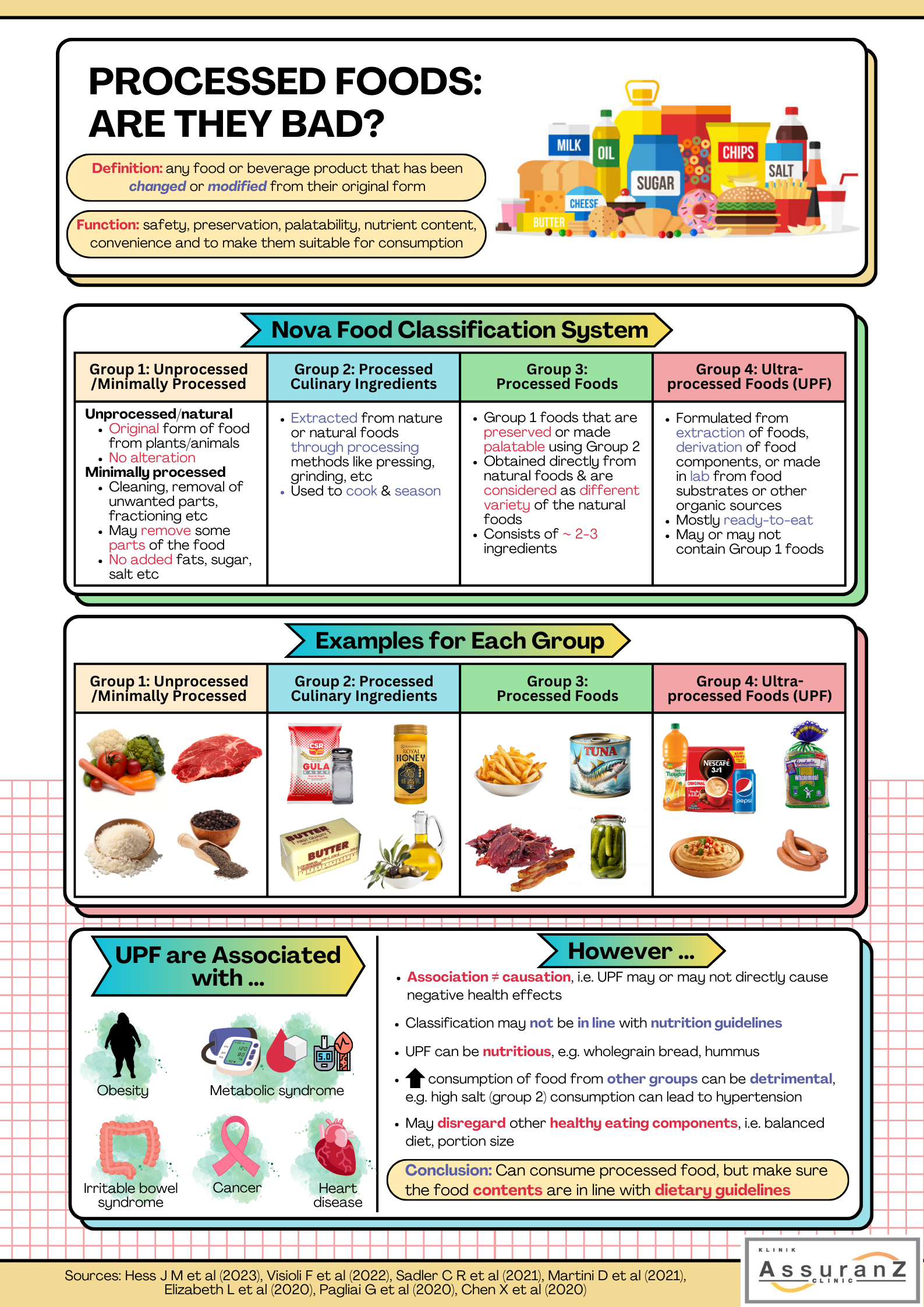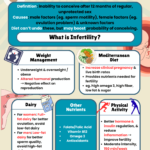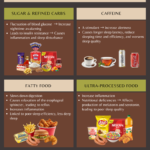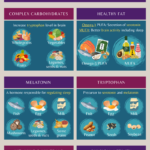Non-communicable diseases (NCDs) and their risk factors have been on the rapid rise in Malaysia. Among them include obesity, diabetes mellitus and heart disease, all of which worryingly contribute to the growing burden in the healthcare system, poor quality of life and premature mortality. Healthy eating plays an important role in combating the progression of the diseases. Meanwhile, the advancement of technology has made it possible for the efficient production of food in abundance. However, these foods, also known as processed foods, are often associated with unhealthy eating and NCDs. Is this true?
非传染性疾病(NCDs)及其风险因素在马来西亚有迅速上升的趋势,其中包括肥胖症、糖尿病和心脏病。这些都令人担忧,并对日益沉重的医疗负担、较差的生活质量和过早的死亡率产生了不良影响。健康饮食在抵抗这些疾病的进展中发挥着重要作用。与此同时,科技的进步使得食品能够高效大规模生产。因而这些食品被称为加工食品,还经常与不健康的饮食和非传染性疾病有关。这是事实吗?
Processed food generally refers to any food or beverage product that has been changed or modified from their original form when they are made or prepared. The food that we consume daily is mostly processed in some way. Food processing is done for various reasons, including safety (such as pasteurizing dairy products), preservation (such as canned food), palatability (such as adding flavourings), nutrient content (such as fortification of vitamins), convenience (such as prepackaged meal) and to make them suitable for consumption (such as extracting oil from plants). Aside from that, food processing allows access to a bigger range of food choices throughout the year for food that are not readily available. There are many methods to process food, like freezing, canning, drying, fermenting, chemical modification et cetera. Therefore, processed food does not necessarily equate to unhealthy eating and NCDs. Then, is processed food completely harmless?
加工食品通常指任何在制作或准备过程中,经过改变或修改原始形态的食品或饮料产品。我们日常食用的大部分食品在某种程度上都经过了加工。食品加工有很多原因,包括确保安全性(如巴氏杀菌乳制品)、延长保存期(如罐装食品)、提升口感(如添加调味料)、增加营养成分(如强化维生素)、提供便利(如重新包装的肉类)以及使其更适合使用(如从植物中提取油)。此外,食品加工还使我们能够全年享用一些平时难以获得的食品。常见的食品加工方法有冷冻、罐装、干燥、发酵、化学改性等。因此,加工食品并不等同于不健康饮食或非传染性疾病。那么,加工食品完全无害吗?
To answer this question, it is important to understand the technicalities of food processing levels. Food can be classified into four groups of processing level according to the widely used Nova Food Classification system by the Centre for Epidemiological Studies in Health and Nutrition, University of Sao Paulo, which are:
在回答这个问题之前,首先需要先了解食品加工的不同层次。根据圣保罗大学流行病学与营养研究中心广泛使用的Nova食品分类系统,食品可分为四类加工层次,具体如下:
Group 1: Unprocessed/Minimally processed
第一类:未加工/最少加工
Unprocessed or natural foods are the original form of food from plants or animals without undergoing any alteration. For example, vegetables, fruits, fish and eggs. Minimally processed foods are foods that undergo cleaning, removal of unwanted parts, fractioning, drying, grinding et cetera that may remove some part of the food with no addition of oils, fats, sugar, salt and other substances. For example, butchered meat, frozen vegetables, rice, pasta, dried herbs and pasteurised milk.
未加工或天然食品是指来自植物或动物的原始形态食品,未经过任何改变。例如:蔬菜、水果、鱼类和鸡蛋。最少加工食品是指经过清洗、分割、干燥、研磨等处理的食品,这些处理可能去除部分食材,但没添加油脂、糖、盐或其他物质。例如:屠宰后的肉类、冷冻蔬菜、大米、意大利面、干草药和巴氏杀菌奶。
Group 2: Processed culinary ingredients
第二类:加工烹饪原料
Processed culinary ingredients are food extracted from nature or natural foods through processing methods like pressing, grinding and refining. These ingredients are used to cook and season food. These include oils such as palm oil, fats such as butter, salts, sugar and syrup such as honey and maple syrup.
加工烹饪原料是通过压榨、研磨、精炼等加工方法,从天然的食材中提取出来的食品原料。这些原料用于烹饪和调味,包括油类(如棕榈油)、脂肪类(如黄油)、盐、糖以及糖浆(如蜂蜜和枫糖浆)等。
Group 3: Processed food
第三类:加工食品
Processed foods are unprocessed or minimally processed foods that are preserved or made palatable by using processed culinary ingredients. These products are obtained directly from the natural foods and are acknowledged as another variety of the foods. Typically, two to three ingredients are used in the process. Examples of processed foods are preserved vegetables, canned legumes, tomato paste, beef jerky, salted nuts, canned fish, cured meat and fermented alcoholic beverages.
加工食品是通过使用加工烹饪原料来保存或使未加工或最少加工的食品变得更加美味的食品。这些产品来自天然食品,并被视为另一种食品形式。通常,加工过程会使用两到三种原料。加工食品的例子包括腌制蔬菜、罐装豆类、番茄酱、牛肉干、咸坚果、罐装鱼、腌制肉类和发酵酒类饮料。
Group 4: Ultra-processed food (UPF)
第四类:超加工食品(UPF)
UPF are industrial products formulated from extraction of foods (such as oils, fats, sugar, starch and proteins), derivation of food components (such as modified starch and hydrogenated oil), or made in laboratories from food substrates or other organic sources (such as colours, additives and flavour enhancers). These foods are mostly ready-to-eat, and in the making of the products, only a small portion of unprocessed or minimally processed food is used. Some do not contain group 1 food at all. The examples of UPF are cookies, soft drinks, canned or powdered soup, pre-prepared meat, nuggets, powdered drinks, and distilled alcoholic beverages.
超加工食品(UPF)是通过提取食品中的成分(如油脂、糖、淀粉和蛋白质)、衍生食品成分(如改性淀粉和氢化油),或在实验室中使用食品基质或其他有机来源(如色素、添加剂和调味剂)制造的工业产品。这些食品大多是即食型,制作过程中仅使用少量加工或微加工的食品成分。有些甚至完全不包含第一类食品。超加工食品的例子包括饼干、软饮料、罐装或即溶汤、预制肉类、鸡块、即溶饮料和蒸馏酒类等。
A lot of foods from the UPF category contain high calories, saturated fat, salt, added sugar, other additives and are low in fibre, vitamins and minerals. Evidence suggests that high intake of UPF is associated with various negative health outcomes including obesity, metabolic syndrome, heart disease and higher death risk. Some research also associates high intake of UPF with irritable bowel syndrome, hypertension, depression, and overall cancer. However, the relationships are mostly association rather than causation, meaning that while they are related, UPF may or may not be the direct cause of the adverse health outcomes.
许多超加工食品(UPF)含有高热量、饱和脂肪、盐、添加糖和其他添加剂,同时缺乏纤维、维生素和矿物质。研究表明,高摄入UPF与多种负面健康问题相关,包括肥胖、代谢综合征、心脏病以及较高的死亡风险。一些研究还将高摄入量的UPF与肠易激综合征、高血压、抑郁症和整体癌症风险联系在一起。然而,这些关系大多是相关性而非因果关系,也就是说,尽管它们相关,UPF可能并非是这些健康问题的直接原因。
Moreover, classification solely based on the processing method may not align with the nutritional guidelines. Some highly nutritious food, such as hummus, whole grain bread and high fibre breakfast cereal can be classified as UPF. On the other hand, the use of excessive ingredients from other classes can also lead to undesirable health effects. For instance, excessive consumption of sugar, salt and butter can contribute to NCDs such as diabetes, high cholesterol, hypertension and obesity. Focusing entirely on food processing methods may also exclude consideration to balanced diet and appropriate portion size.
此外,仅凭加工方法对食品进行分类可能与营养指南不符。一些富有营养的食物,如鹰嘴豆泥、全麦面包和高纤维早餐麦片,可能会被归类为超加工食品(UPF)。另一方面,过度使用其他类别的食材也可能导致不良的健康影响。例如过量摄入糖、盐和黄油可能导致慢性非传染性疾病,如糖尿病、高胆固醇、高血压及肥胖。如果仅仅关注食品加工方式,也可能忽略了均衡饮食和适当分量的重要性。
Therefore, to achieve a healthy balanced diet, knowing what you are eating is important. If processed food is consumed, one should check the nutrition label, and make sure that the contents of the food to be consumed are in line with the dietary guidelines.
因此,为了实现健康均衡的饮食,了解自己所摄入的食物非常重要。如果食用了加工食品,应该查看营养标签,确保其成分符合饮食指南。






